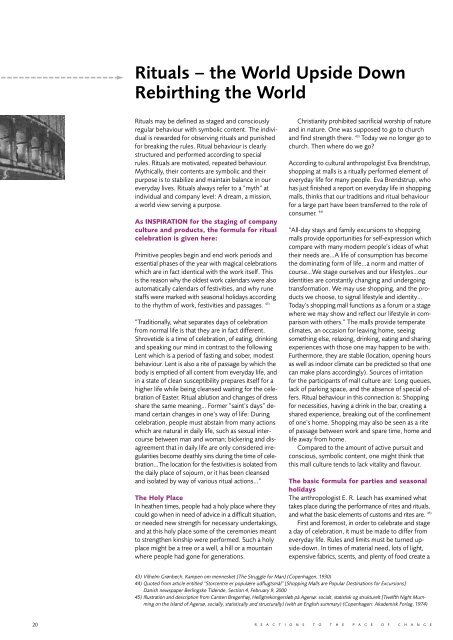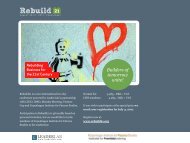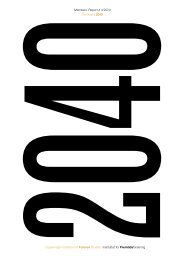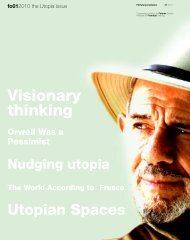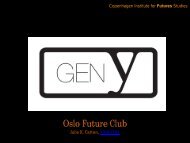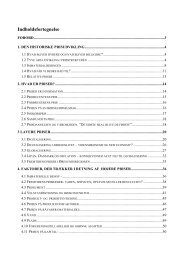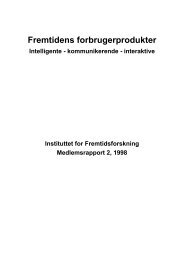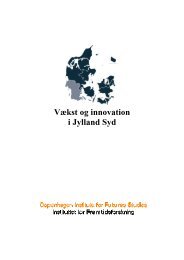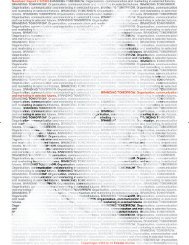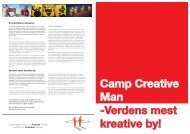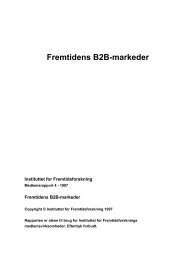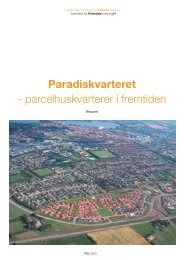Rituals – <strong>the</strong> World Upside DownRebirthing <strong>the</strong> WorldRituals may be defined as staged and consciouslyregular behaviour with symbolic content. The individualis rewarded for observing rituals and punishedfor breaking <strong>the</strong> rules. Ritual behaviour is clearlystructured and performed according <strong>to</strong> specialrules. Rituals are motivated, repeated behaviour.Mythically, <strong>the</strong>ir contents are symbolic and <strong>the</strong>irpurpose is <strong>to</strong> stabilize and maintain balance in oureveryday lives. Rituals always refer <strong>to</strong> a “myth” atindividual and company level: A dream, a mission,a world view serving a purpose.As INSPIRATION for <strong>the</strong> staging <strong>of</strong> companyculture and products, <strong>the</strong> formula for ritualcelebration is given here:Primitive peoples begin and end work periods andessential phases <strong>of</strong> <strong>the</strong> year with magical celebrationswhich are in fact identical with <strong>the</strong> work itself. Thisis <strong>the</strong> reason why <strong>the</strong> oldest work calendars were alsoau<strong>to</strong>matically calendars <strong>of</strong> festivities, and why runestaffs were marked with seasonal holidays according<strong>to</strong> <strong>the</strong> rhythm <strong>of</strong> work, festivities and passages. 43)“Traditionally, what separates days <strong>of</strong> celebrationfrom normal life is that <strong>the</strong>y are in fact different.Shrovetide is a time <strong>of</strong> celebration, <strong>of</strong> eating, drinkingand speaking our mind in contrast <strong>to</strong> <strong>the</strong> followingLent which is a period <strong>of</strong> fasting and sober, modestbehaviour. Lent is also a rite <strong>of</strong> passage by which <strong>the</strong>body is emptied <strong>of</strong> all content from everyday life, andin a state <strong>of</strong> clean susceptibility prepares itself for ahigher life while being cleansed waiting for <strong>the</strong> celebration<strong>of</strong> Easter. Ritual ablution and changes <strong>of</strong> dressshare <strong>the</strong> same meaning… Former “saint’s days” demandcertain changes in one’s way <strong>of</strong> life: Duringcelebration, people must abstain from many actionswhich are natural in daily life, such as sexual intercoursebetween man and woman; bickering and disagreementthat in daily life are only considered irregularitiesbecome deathly sins during <strong>the</strong> time <strong>of</strong> celebration…Thelocation for <strong>the</strong> festivities is isolated from<strong>the</strong> daily place <strong>of</strong> sojourn, or it has been cleansedand isolated by way <strong>of</strong> various ritual actions…”The Holy PlaceIn hea<strong>the</strong>n times, people had a holy place where <strong>the</strong>ycould go when in need <strong>of</strong> advice in a difficult situation,or needed new strength for necessary undertakings,and at this holy place some <strong>of</strong> <strong>the</strong> ceremonies meant<strong>to</strong> streng<strong>the</strong>n kinship were performed. Such a holyplace might be a tree or a well, a hill or a mountainwhere people had gone for generations.Christianity prohibited sacrificial worship <strong>of</strong> natureand in nature. One was supposed <strong>to</strong> go <strong>to</strong> churchand find strength <strong>the</strong>re. 43) Today we no longer go <strong>to</strong>church. Then where do we go?According <strong>to</strong> cultural anthropologist Eva Brendstrup,shopping at malls is a ritually performed element <strong>of</strong>everyday life for many people. Eva Brendstrup, whohas just finished a report on everyday life in shoppingmalls, thinks that our traditions and ritual behaviourfor a large part have been transferred <strong>to</strong> <strong>the</strong> role <strong>of</strong>consumer. 44)“All-day stays and family excursions <strong>to</strong> shoppingmalls provide opportunities for self-expression whichcompare with many modern people’s ideas <strong>of</strong> what<strong>the</strong>ir needs are…A life <strong>of</strong> consumption has become<strong>the</strong> dominating form <strong>of</strong> life…a norm and matter <strong>of</strong>course…We stage ourselves and our lifestyles…ouridentities are constantly changing and undergoingtransformation. We may use shopping, and <strong>the</strong> productswe choose, <strong>to</strong> signal lifestyle and identity…Today’s shopping mall functions as a forum or a stagewhere we may show and reflect our lifestyle in comparisonwith o<strong>the</strong>rs.” The malls provide temperateclimates, an occasion for leaving home, seeingsomething else, relaxing, drinking, eating and sharingexperiences with those one may happen <strong>to</strong> be with.Fur<strong>the</strong>rmore, <strong>the</strong>y are stable (location, opening hoursas well as indoor climate can be predicted so that onecan make plans accordingly). Sources <strong>of</strong> irritationfor <strong>the</strong> participants <strong>of</strong> mall culture are: Long queues,lack <strong>of</strong> parking space, and <strong>the</strong> absence <strong>of</strong> special <strong>of</strong>fers.Ritual behaviour in this connection is: Shoppingfor necessities, having a drink in <strong>the</strong> bar, creating ashared experience, breaking out <strong>of</strong> <strong>the</strong> confinemen<strong>to</strong>f one’s home. Shopping may also be seen as a rite<strong>of</strong> passage between work and spare time, home andlife away from home.Compared <strong>to</strong> <strong>the</strong> amount <strong>of</strong> active pursuit andconscious, symbolic content, one might think thatthis mall culture tends <strong>to</strong> lack vitality and flavour.The basic formula for parties and seasonalholidaysThe anthropologist E. R. Leach has examined whattakes place during <strong>the</strong> performance <strong>of</strong> rites and rituals,and what <strong>the</strong> basic elements <strong>of</strong> cus<strong>to</strong>ms and rites are. 45)First and foremost, in order <strong>to</strong> celebrate and stagea day <strong>of</strong> celebration, it must be made <strong>to</strong> differ fromeveryday life. Rules and limits must be turned upside-down.In times <strong>of</strong> material need, lots <strong>of</strong> light,expensive fabrics, scents, and plenty <strong>of</strong> food create a43) Vilhelm Grønbech, Kampen om mennesket [The Struggle for Man] (Copenhagen, 1930)44) Quoted from article entitled “S<strong>to</strong>rcentre er populære udflugtsmål” [Shopping Malls are Popular Destinations for Excursions]Danish newspaper Berlingske Tidende, Section 4, February 9, 200045) Illustration and description from Carsten Bregenhøj, Helligtrekongersløb på Agersø: socialt, statistisk og strukturelt [Twelfth Night Mummingon <strong>the</strong> Island <strong>of</strong> Agersø, socially, statistically and structurally) (with an English summary) (Copenhagen: Akademisk Forlag, 1974)20 R E A C T I O N S T O T H E P A C E O F C H A N G E
BBfestive atmosphere. Being <strong>of</strong>f-duty and not having <strong>to</strong>chop time up in<strong>to</strong> small intervals makes <strong>the</strong> holiday differfrom everyday life, and constitutes its special time.At New Year’s in medieval times, <strong>the</strong> bishops letall <strong>the</strong> parish clerks wear bishops’ hats, stick out <strong>the</strong>ir<strong>to</strong>ngues and make fun <strong>of</strong> everything holy, even in<strong>the</strong> choir, as a kind <strong>of</strong> res<strong>to</strong>ration gesture. Lettingeverything die in order that it may be born and able<strong>to</strong> stand once again. There is a deeply-rooted beliefin balance through counterbalance and quid pro quoin many <strong>of</strong> our traditions and ritual rules.A good reason for drinking <strong>to</strong> Christmas was <strong>to</strong> avoidscarcity. By giving thanks <strong>to</strong> <strong>the</strong> gods, i.e. <strong>the</strong> naturalforces, for this year’s abundance (even if more wouldhave been welcomed), one shows symbolically that<strong>the</strong>re is plenty, and that one will gratefully acceptthis again next year.In Norway it was every man’s duty <strong>to</strong> celebrateChristmas night with an ale-feast thanking Christand Mary, and in harvest, at <strong>the</strong> latest around Halloween,<strong>the</strong> village was supposed <strong>to</strong> ga<strong>the</strong>r for a collectivedrinking feast for Christ and Our Lady. Thisfeast was <strong>to</strong> consist <strong>of</strong> a company <strong>of</strong> at least threepeople, one for each peasant and one for his wives.For anyone who lived alone, this company was necessarilysubstituted by drinking beer for three. 43)Any person ignoring Christmas and <strong>the</strong> Christmasfeast had <strong>to</strong> pay a fine <strong>of</strong> three marks, and if he missed<strong>the</strong> blessing <strong>of</strong> <strong>the</strong> ale-feast three years in a row,he was bound <strong>to</strong> stay beyond <strong>the</strong> King’s jurisdiction,and <strong>the</strong> King had <strong>to</strong> see <strong>to</strong> it that such a hea<strong>the</strong>n didnot stay in Norway.The pietistic modesty <strong>of</strong> being frugal even at times<strong>of</strong> celebration means – seen in this perspective – tha<strong>to</strong>ne paves <strong>the</strong> road for continued scarcity, and tha<strong>to</strong>ne does not know how <strong>to</strong> administer abundance!Rites <strong>of</strong> passageBetween everyday life and celebration – <strong>the</strong> normalcondition and <strong>the</strong> exception – <strong>the</strong>re is a passage whichmust proceed as a shift between <strong>the</strong> two opposites.Masking is an obvious way <strong>of</strong> signalling <strong>the</strong>se shiftsand helping <strong>the</strong>m along, and traditionally it has <strong>the</strong>reforebeen used for this purpose. Masks are wornduring celebrations, for instance at Shrovetide, NewYear, Christmas and Twelfth Night mumming etc.,and being disguised, people are free <strong>to</strong> do festivethings – here festive in <strong>the</strong> sense <strong>of</strong> reversed affairs,unusual actions, where everything is turned up-sidedown– and at <strong>the</strong> end <strong>of</strong> <strong>the</strong> celebration, <strong>the</strong> unmaskingand identification takes place. The masks ensurethat <strong>the</strong> participants do not have <strong>to</strong> be <strong>the</strong>ir usual selvesand are allowed <strong>to</strong> behave differently than usual.In return, disguise demands someone and something<strong>to</strong> disguise oneself for. If one’s behaviour is <strong>the</strong>same irrespective <strong>of</strong> <strong>the</strong> mask, <strong>the</strong> masking serves no purpose.Then wearing a mask becomes boring and drab.ACelebrationCTimeEveryday life that is never reversed also becomesdull, cf. Enzensberger’s rule about <strong>the</strong> excitement <strong>of</strong>“what is contrary <strong>to</strong> <strong>the</strong> principle <strong>of</strong> reality.” What isa weekend <strong>to</strong> someone who is bored, mountain climbing<strong>to</strong> someone who always climbs mountains, orpork roast <strong>to</strong> someone who eats it every day?The basic formula for rituals are A: Preparing <strong>the</strong> “party,”<strong>the</strong> exception, <strong>the</strong> rite, intensifying <strong>the</strong> formal aspect– making a caricature <strong>of</strong> or stressing one’s fake identity.The culmination B equals <strong>the</strong> occasions when <strong>the</strong>participants appear as <strong>the</strong> exact opposite <strong>of</strong> what <strong>the</strong>yare in reality: Men performing as women, women asmen, children as adults, gentle personalities as witches,kings as beggars, waiters as masters, parish clerks asbishops. In <strong>the</strong> course <strong>of</strong> regular orgies like <strong>the</strong>se,normal social life is acted in reverse, and all kinds <strong>of</strong>sins such as incest, adultery, transvestism, sacrilege,and lese-majesty are considered <strong>the</strong> natural order <strong>of</strong><strong>the</strong> day (an exchange <strong>of</strong> roles).And C, which is <strong>the</strong> opposite <strong>of</strong> A, is <strong>the</strong> phase <strong>of</strong>unmasking when <strong>the</strong> formal and exceptional fadesin<strong>to</strong> <strong>the</strong> usual condition <strong>of</strong> normality.In cus<strong>to</strong>ms <strong>of</strong> disguise, masking provides <strong>the</strong> individualswith opportunities <strong>to</strong> act o<strong>the</strong>r roles than thosewhich society expects from <strong>the</strong>m. Their symbolic deathbecomes <strong>the</strong>ir rebirth. By having passed through aperiod as a different person, it is possible <strong>to</strong> return<strong>to</strong> one’s everyday role as a “new” human being.We may choose <strong>to</strong> regard <strong>the</strong> search for holidaydestinations so different from everyday life as <strong>the</strong>wilderness, or <strong>the</strong> search for high-risk sports as Bphases where everyday life is turned up-side-down,and life is radically pushed <strong>to</strong> extremes.In life forms with opaque or complex structures,it is not possible <strong>to</strong> set up <strong>the</strong> binary opposition <strong>of</strong>celebration vs. everyday life unless we view <strong>the</strong>exception as a primarily “set structure.” That wouldmake basically any kind <strong>of</strong> ritual behaviour, set <strong>of</strong>rules or clear strategy attractive and festive.In this sense it becomes natural for a modern,Western and individually free and <strong>to</strong>lerant society <strong>to</strong>adopt cus<strong>to</strong>ms and festival traditions from all parts<strong>of</strong> <strong>the</strong> world irrespective <strong>of</strong> <strong>the</strong>ir symbolic contents.At this level, it is <strong>the</strong> only <strong>the</strong> form – <strong>the</strong> presence<strong>of</strong> rules and a clear structure – that is attractive.So what is it that rituals and traditions can do thatwe need? TheyStructure and put everyday life in<strong>to</strong> perspectiveAre a means <strong>of</strong> uniting and creating communitiesAre occasions for a renewed staging <strong>of</strong> selfFree us from dull, inflexible patterns <strong>of</strong> behaviourKeep <strong>the</strong> focus on constants during changes• Maintain areas <strong>of</strong> competence and thus create abasis for developmentAEveryday LifeCelebrationCC O P E N H A G E N I N S T I T U T E F O R F U T U R E S S T U D I E SM E M B E R S R E P O R T 1 / 2 0 0 021


